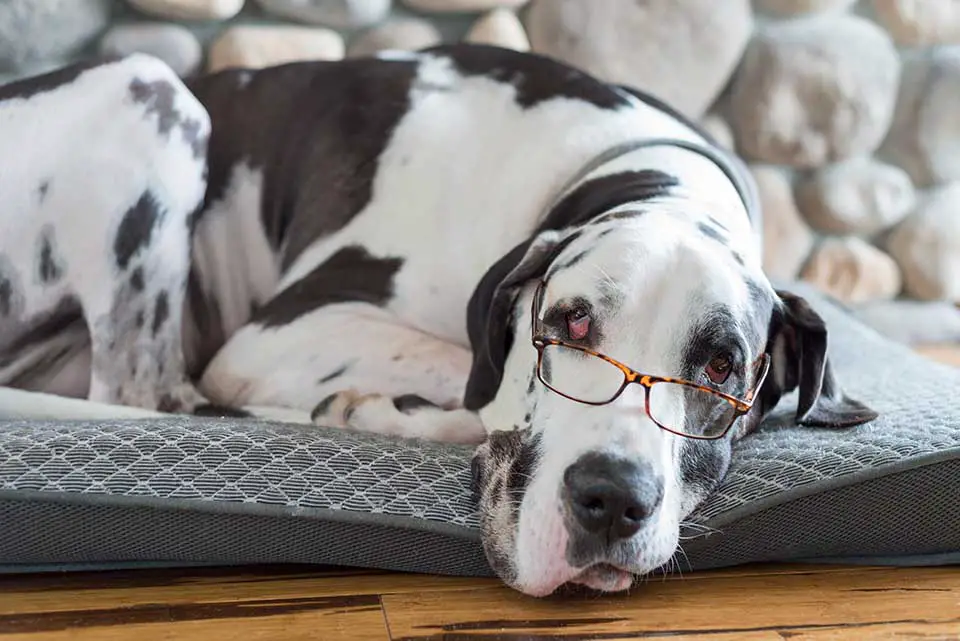Is your dog having trouble getting from place to place? Or, maybe you’ve been noticing something unusual appear in or around your pooch’s eyes. Either way, these are signs that your dog may be in need of visiting an animal ophthalmologist, which is a fancy word for a veterinarian who specializes in treating eye disorders in animals. In this post, we’ll discuss whether your pet needs an ophthalmologist and how to choose the best eye doctor for your dog. Let’s jump in.
Article contents
How to find the best eye doctor for dogs
Veterinary ophthalmologists are equipped to diagnose all kinds of eye issues, whether they’ve formed on their own or have stemmed from another disease, such as diabetes. As such, animal eye doctors are more qualified and more experienced to perform these types of surgeries. They also have access to more specialized equipment, which allows them to perform these delicate surgeries as well as highly detailed eye exams.
Not only that but thanks to the mapping of the dog genome, which was completed in 2005, veterinary ophthalmologists are now moving into the field of gene therapy. This can help filter out which genes are responsible for inherited eye diseases, remove them, and replace them with healthier genes in breeds that are known to be predisposed to these conditions.
Just like eye doctors for people, animal ophthalmologists are adept at performing eye exams, non-invasive procedures to help correct and restore an animal’s vision, and even eye surgery. When it comes to your dog’s eyesight, you certainly want the best people tending to his every need. Yet, how do you know which doctor is right for your dog?
The best way to determine that is to ask your regular vet for a recommendation. They’ll refer you to someone they know personally or have had dealings with on a professional level to ensure they can provide you and your pooch with the most comprehensive care possible. Another thing you can do is check out the specialist database set up by the American College of Veterinary Surgeons (ACVS).

When to Take Your Dog to an Eye Doctor
Not all eye conditions need an ophthalmologist. Some issues are pretty straightforward and can be easily dealt with by your regular veterinarian. These are common eye conditions that can be corrected with basic treatments, such as conjunctivitis. However, if you, or your vet, feel that your dog is suffering from a complex eye condition, then chances are, they’ll need to be checked out by an ophthalmologist.
Animal ophthalmologists are certified to perform all types of eye surgery if your dog should need it. This includes cataract surgery, corneal transplants, retinal procedures, glaucoma surgeries, and eyelid surgeries. Yet, your dog could be suffering from something as simple to diagnose and treat as cataracts. On the other hand, there’s always the possibility that it could be something more serious that requires a detailed examination followed by a complex surgery.
Some of the diseases eye dog specialists have experience treating include:
- Cataracts: an eye condition caused by the clouding of the eye lens, causing blurry eyesight and possibly a complete loss of vision
- Cherry eye: an eye condition where the eyelid swells up, giving the appearance that the eye is covered with a red bump
- Dry eye syndrome: also known as Keratoconjunctivitis Sicca (KCS), is when there’s a noticeable decrease in tear production
- Glaucoma: dog breeds that are especially susceptible to this eye disease are the Basset Hound, Beagle, and Cocker Spaniel
- Pannus: an eye condition commonly found in older German Shepherds where lesions will gradually grow until they cover the entire cornea
What to Expect When You Take Your Dog to an Eye Doctor
When you take your dog to see a veterinary ophthalmologist, they’ll start off by performing a thorough eye exam, which will likely take about an hour. In most places, you can stay with your dog in the exam room. Many times, the doctor will leave the dog in your lap to help calm and reassure m during the examination. To examine the entire structure of the eye, as well as the eyelids, the doctor will use an array of equipment specially made for pet eye exams. They’ll also use lights to shine into the eye itself to assess the state of your animal’s pupils and iris and check for signs of allergies, infections, or inflammations.
Symptoms of eye problems in dogs
During the initial examination, the animal ophthalmologist will likely ask you if you’ve noticed your dog showing one or more of the symptoms listed below:
- Avoiding light
- Bulging eyes
- Bumping into things, particularly at night
- Constant rubbing of the eyes or face
- Difficulty getting around
- Discoloration or cloudiness in the cornea or lens of the eye
- Excessive discharge
- Film over the eye
- Frequent squinting
- Redness or discoloration in or around the eyes
- Squinting or keeping eyes closed
Diagnostic tools and equipment
Here are a few examples of some of the diagnostic tools veterinary ophthalmologists use to help diagnose and treat specific eye disorders:
- Fluorescein Stain: is used to check for corneal ulcers
- Indirect ophthalmoscopy: is used to examine the back of the eye
- Pupillary light reflex test: is used to examine the retina
- Schirmer tear test: is used to check for dry eye conditions and to evaluate tear production
- Slit lamps: is used to examine the anterior chambers of your dog’s eyes
- Tonometry: is used to check for intraocular pressure
Making sense of it all
As a dog lover, you can immediately see how much love and affection your dog has for you reflected in their big, brown eyes. Unfortunately, sometimes, those beautiful eyes can also show signs of a possible health condition. Yet, because dogs can’t respond to vision assessments or eye charts, determining the exact cause of the problem can be tricky.
Luckily, a qualified eye doctor for dogs can help pinpoint exactly what your pooch is suffering from. Through various eye exams and tests, they’ll be able to come up with a remedy to cure your dog’s eye condition and improve their eyesight.
